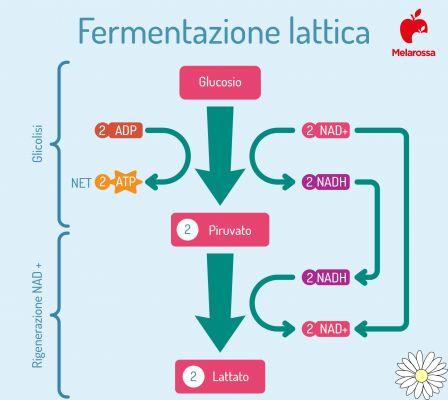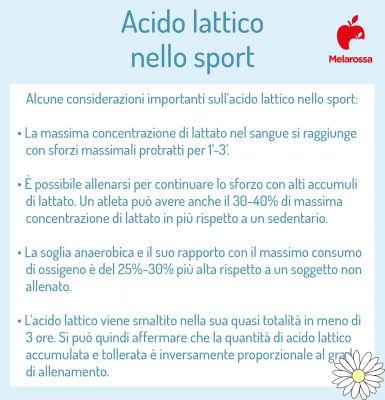Lactic acid it is an organic compound naturally present in our body but toxic to cells. Lactic acid begins to be produced with low intensity exercises, and then accumulate in the tissues as the intensity of physical activity increases.
Its accumulation causes the feeling of muscle fatigue and involves a reduction in the intensity of the exercise. Then, the lactate circulating in the blood is disposed of almost entirely a few hours after the end of physical activity. In the following article we will deepen the lactic acid formation process, the role of lactate in sports and how to improve its tolerance and disposal.
What is lactic acid
It is the final product of the anaerobic glycolysis. Basically it is a chemical compound produced by our body through the process of anaerobic cellular respiration (without oxygen). This happens when ours cells require more energy than they can produce, whether this is due to physical activity or due to a pathology.
Anaerobic glycolysis allows the production of ATP (the molecule that provides the cell with the energy it needs to carry out its biological functions), the energy currency of the cell, in tissues, particularly in those in which the supply of oxygen is lacking or not sufficient.
Lactic acid is one toxic to cells and, with increasing accumulation in the blood in the form of lactate, it leads to what we call "fatigue". Sometimes so intense as not to allow us to continue the activity, precisely because of the accumulation of lactate that interferes with the normal processes of muscle contraction.

Because it is formed
Lactic acid is constantly formed in our body, about 120 grams per day, and is converted to glucose from the liver. Then, in resting conditions, the lactic acid is completely disposed of and metabolized.
La production during strenuous physical activity (over about 12 seconds) increases to such an extent that the body is no longer able to dispose of it, and this is how the lactic acid concentration increases.
Once the lactic acid moves from the muscle to the bloodstream it changes its chemical structure, losing an ion (H +), and therefore takes the name of lactate.
There are three forms of lactic acid: D-lactic, L-lactic and DL-lactic.
It is the L-lactic form that which it accumulates in significant quantities within the muscle and we can also find it in other fabrics such as blood and liver.
D-lactic is present in nature or biosynthesized starting from glucose by exploiting the action of a bacterium. Lactic acid is also used in various industrial processes and in medicine.
When the level of lactic acid circulating in your body exceeds the disposal capacity, here comes muscle fatigue.
DOMS or lactic acid buildup?
Delayed onset muscle pain (DOMS) that occurs the day after a workout is often mistakenly confused with a buildup of lactic acid, on the other hand, it is due to the micro tissue lesions of the muscle.
All athletes have heard of lactic acid at least once. Often, however, the information is not clear or, even worse, it is incorrect.
We assume that the muscle pain of the following days (DOMS) is not related to lactic acid, as some still think. DOMS are triggered by muscle microlesions and cause an inflammatory state triggered by new high intensity stimuli.
Le "Stiff legs" or the feeling of fatigue are the most recognized symptoms. Immediately, do some exercises stretching and aerobic cool-down (even just a light walk) brings immediate benefit. Furthermore, the breathing during exercises it matters why serves to restore oxygen levels in your body.
Even a hot bath or sauna after an intense workout relax muscles and increase blood circulation, therefore accelerate the recycling of blood and the disposal oflactic acid.

Lactic acid in the muscles: how it forms and symptoms
human body cells need energy to function and carry out physiological processes. Just like a car, the human body needs fuel that it can transform into energy that will then be used for physiological activities.
Il fuel of the human body is basically food that we ingest daily, along with liquids. Carbohydrates, proteins and fats are the macronutrients that are metabolized and converted into usable energy.
In the case of muscles we are talking about ATP (adenosine triphosphate). It is precisely this "energy currency"Of the body that allows all of our muscles to form, as well as intervening in numerous vital processes.
However, ATP is present in small amounts within muscle tissue. Simply put, the our ATP stocks are very scarce, for this reason it is necessary that the "energy currency" be produced continuously.
La production need depends on the energy demand. Just like in a car, the harder we press on the accelerator, the more fuel will enter the engine and the more we will consume.
Hence, the ATP needed varies according to the type of physical activity we are doing. We can divide the types of effort into two macro categories:
- Anaerobic
- Aerobic.
Aerobic and anaerobic activity
Without going into specific details, the ATP synthesis processes are part of a very complex cycle that releases a number of waste substances and metabolites.
If we talk about aerobic activity, there will still be a production of lactic acid, but being there'medium-low intensity, the body will be able to metabolize the lactate present in the blood and thus keep it below the levels that would compromise muscle contraction.
If instead theactivity is anaerobic, we have two "ways". There first it represents a short-lived effort, maximum 15 seconds, where lactic acid does not accumulate.
Instead, the second represents the energy system that causes the greatest accumulation of lactate: the anaerobic lactacid. A maximum intensity effort lasting 2 minutes leads the lactate levels to exceed the threshold, precisely lactacid, where this metabolite will start to create problems for the body.
these three energy systems do not travel in watertight compartments but they must be imagined as three very nuanced and superimposable limits.
Remaining on the example of the lactate anaerobic system, if continued to exhaustion, the point will be reached where physical activity will have to drastically reduce in intensity or even be suspended because muscle contraction will be heavily inhibited. It's classic wooden legs and nauseous feeling.
However, lactate tolerance is subjective and trainable.
Muscle fatigue
Il clearer symptom of an accumulation of lactic acid it is easily recognizable even by the less experienced person: muscle fatigue.
Behind the feeling of muscle fatigue, sometimes pain and stiff muscles, but there is one state of increased muscle vulnerability. That is, the muscle is lowering its defenses and this it increases the likelihood of injuries and muscle injuries.
It is therefore important, in untrained subjects, to reduce the intensity when this symptomatology is perceived.

How lactic acid is formed
To go into the details of the formation of lactic acid we must go back to what was mentioned in the previous paragraph. We have described how the fuel for our body is composed of the three macro-foods and liquids.
Glucose metabolism is the key process for ATP production. In normal or low intensity conditions, the body uses oxygen to synthesize glucose through glycolysis. Aerobic respiration, with minimal production of lactic acid, which is easily disposed of by the body.
In the moment in which the energy demand increases due to intense physical activity, the aerobic cycle for ATP production is no longer sufficient.
We therefore need a new one energy source that releases more ATP. We find the answer in anaerobic cycle, where the energy produced is considerably higher but also the price to pay in terms of waste and metabolites rises.
What happens then? During the synthesis of glucose (glycolysis), pyruvate (end product of glycolysis) is formed which, under anaerobic conditions, binds to hydrogen ions (waste from glycolysis) and becomes lactic acid.
This process also takes place within the muscle tissue (myocytes), and it is the reason why an accumulation of lactate leads to the perception of muscle fatigue and pain that obliges the athlete to limit the effort.
However, lactic acid does not remain inside the muscle, enters the bloodstream (lactate) which takes it back to the liver. It will then be the liver that transforms lactate into pyruvic acid and starts glycolysis again.

How to dispose and eliminate lactic acid: all the remedies
Lactic acid is a metabolite of the ATP production process, a waste. The human body, however, in its perfection, it is also able to exploit waste and use them for other physiological functions.
Hence, it can be understood as a waste in that toxic substance and to be eliminated, but its elimination process is optimized to make it useful anyway.
Il Cori cycle, inside the liver, transforms lactate into pyruvic acid and makes it available for glycolysis and glucose synthesis. It is also used by the heart as a source of energy and by red muscle fibers.
In practice, the best activity to dispose of lactic acid is to continue physical exercise after the training session for at least 15 minutes at very low intensity.
Aerobic activity favors the reuptake of lactate by the red muscle fibers and by the heart. More, respiratory activity favors a return to the balance of the intracellular PH by eliminating CO2.
It is important to emphasize how tolerance to lactate and its disposal are related to genetics and training. Indeed, a trained subject will be able to work at higher intensities thanks to its lactate tolerance capacity, as well as an optimization of its disposal.
Thus, an athlete will have a much higher lactic acid accumulation threshold, tolerance and disposal capacity than a sedentary.
There are no secrets to improving these skills but always and only the main components of training (and healthy living).
Recent studies have shown that the exercises with the foam roller they help the body more to dispose of lactic acid, to relax the muscle groups and to reduce the level of cortisol.

Training
Training must be focused on improving athletic status but above all on the work in the lactate accumulation threshold.
Nutrition must be healthy and balanced, as with any other healthy lifestyle. The rest is essential to create a progressive curve for improvement. Without breaks and rests there can be no improvement.
Lactic acid in sports
In the context of sports performance, lactic acid becomes a limit, which is why it is important train to delay its build-up (anaerobic threshold), as well as training to be able to continue the activity with significant accumulations of lactate (lactate tolerance).
These two abilities are both trainable but, like any organic parameter, they are subject to genetic characteristics.
All people can improve their lactate tolerance e the anaerobic threshold but only those genetically predisposed will be able to reach the limits.
Some important considerations on lactic acid in sports.
- The maximum concentration of lactate in the blood is reached with maximal efforts protracted for 1'-3 '.
- It is possible to train to continue the effort with high accumulations of lactate. An athlete can also have 30-40% higher maximum lactate concentration than a sedentary.
- The anaerobic threshold and its ratio with maximum oxygen consumption is 25% -30% higher than in an untrained subject.
- Lactic acid is almost completely disposed of in less than 3 hours. It can therefore be said that the amount of lactic acid accumulated and tolerated is inversely proportional to the degree of training.

The role of nutrition: what to eat after (and before) a workout
Nutrition, along with rest and training, is a key point for those who want to lead a healthy life and improve their athletic performance.
A balanced diet based on the classic Mediterranean diet it's a good one starting point for preventing injuries, overtraining and improving performance.
Like any diet, to avoid errors and adverse events, it is very important to rely on the clinician to evaluate management choices together.
In general, but especially to improve lactic acid management, it is important reduce all foods that burden the liver. Among them we find:
- Alcohol
- Sweetened drinks
- fried
- Saturated fats
- Caffeine.
The advice is to train about three hours after your last meal, so that digestion has done its job.
Example of a menu to avoid accumulation of lactic acid
Staying in a training setting to improve lactic acid management, a light meal composed of high quality proteins and complex carbohydrates it is usually a good choice. For example, a portion of brown rice, chicken and vegetables for lunch.
About 30-60 'before anaerobic training it could be useful to consume a fruit to increase the glycemic index and available energy.
Hydration remains fundamental. Drink between meals and sip plain water during your workout. A good hydration improves production and energy expenditure.
After training and cooling down for about 15-20 minutes at a slow pace it is advisable to consume one high glycemic index snack and a source of quality protein.
For convenience, one protein shaker e a banana they could be an effective solution, especially for those short on time.
In case the workout was next to one of the three main meals of the day it is possible to skip the snack and eat the meal even after an hour and a half.
You might also be interested
 Swollen belly
Swollen belly Sports for children
Sports for children Couple sports: benefits and fitness circuit to tone up and improve the relationship
Couple sports: benefits and fitness circuit to tone up and improve the relationship Benefits of swimming: dive into the water to get back in shape
Benefits of swimming: dive into the water to get back in shape Kegel exercises
Kegel exercises Muscle warming
Muscle warming Lose weight while walking: 10 tips to burn more calories!
Lose weight while walking: 10 tips to burn more calories! Fitness shoes: the best gym footwear
Fitness shoes: the best gym footwear stand up paddle
stand up paddle

























